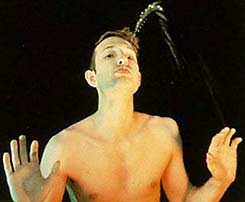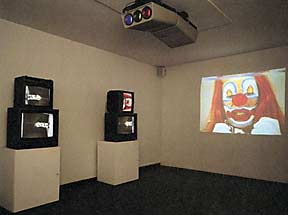Bruce Nauman: Emperor without Clothes
While plotting our next move, which is certain to cause the downfall of the entire postmodern social order in art, a certain plump sacred cow came to mind, the very King of postmodernist minimalism - Bruce Nauman. Hailed by critics, museums and academia as one of the most significant artists living today, Nauman is credited with having influenced legions of conceptual artists through his work in film, sound, video, sculpture and neon. But Nauman and his ilk are not antithetical to the established order, they are the established order, and if there was any doubt about that it should have been erased when Nauman was given the Golden Lion award at the 1999 Venice Biennale. We can’t think of a larger art world sacred cow in need of toppling.

In 1966 Nauman had his debut show at the Nicholas Wilder Gallery in Los Angeles. After being snatched up by New York art dealer Leo Castelli in 1968, Nauman produced an eight minute long movie that was an exercise in tedium but a benchmark for a career based upon the same. Black Balls, a silent black and white film made in 1969, gave spectators the dubious pleasure of watching a close up view of Nauman applying black makeup to his testicles. One of his better known video installations was titled, Clown Torture, a work from 1987 that consisted of separate stacked video screens showing films of a clown sitting on a public toilet, a clown balancing goldfish bowls, a clown reciting a nonsensical story, and a clown repetitively screaming "No, no, no, nonono!"

World Peace was Nauman's 1996 video installation consisting of five separate video players or projectors displaying four women and one man, each prattling separately, endlessly, and inanely about world peace. Their argumentative tone and inability to truly dialog with one another, is proof positive, from the apolitical postmodernist view - that world peace is impossible. The work effectively strips political ideas from the question and reduces the problem to one of so-called "human nature".
Reviewing Nauman's World Peace video installation at New York's Sperone Westwater Gallery, art history professor Donald Kuspit wrote: "Nauman's art has long ridiculed the obvious, just as Duchamp once used the obvious to ridicule art: ridicule reduces whatever it touches to rhetoric, finally rendering it meaningless. In the art world, such facile nihilism passes for critical profundity, indeed philosophical brilliance, when, in fact it is simply farce -- a kind of burlesque of an easy target, indeed, a pushover." Kuspit went on to write that Nauman's art, "however much it seems to be at war with popular ideas, is a product of a culture industry. If not as popular as the Country Western music industry, the high art culture demands the same slick look. Indeed, Nauman's irony has become as slick as his technology."
Another art critic who weighed in on Nauman was Robert Hughes, who in 1995 wrote a review for TIME magazine on the artist’s then running retrospective at New York City’s Museum of Modern Art. In the review, titled Being A Nuisance, Hughes seemed conflicted regarding the legacy of Nauman, calling his art "deliberately off-putting", and "so dumb that you can’t guess whether its dumbness is genuine or feigned." Hughes referred to much of Nauman’s works as "one-liner art, no matter what windy claims surround them." But in surveying all of the jarring and disconcerting artifacts Nauman has left in his wake over the years, Hughes recognized Nauman was playing a new role - artist as nuisance. And there lies the genius of this artist, according to Hughes, who ended up proclaiming Nauman "the most influential American Artist of his generation."
That assertion was bad enough, but Hughes, who should know better, tossed out even more drivel when he said, "The artist as hero is long gone from American culture, and the artist as social critic is ineffective." But who or what makes that so - if the claims are true at all? While it’s correct to say Nauman is neither heroic nor an effective social critic, it’s ill-advised to judge every other artist using the same "lowered bar" standards applied to Nauman. If social criticism in art is "ineffective", are we then to join the postmodernist babblers like Nauman who have nothing to say?
Regarding the supposed death of the artist as hero, just because exemplary artists are ignored by a money driven, media mad society - it doesn’t follow that such champions in fact do not exist. That artists persevere and carry on under present circumstances makes them all the more heroic. Goodness knows heroes frequently have feet of clay, and more often than not have been little more than iconic figures generated to manipulate the public. But there is a stark difference between manufactured and genuine heroes. Nevertheless - how did the artist fall from grace? Have we actually moved to a time when the artist can only aspire to be a nuisance? As it appears to us, bleak days call for laudable thought and action - and the artist just might be among the last American heroes.
<< Home